-
How can I prevent shoulder pain?
How to Prevent Shoulder Pain
You can mitigate shoulder pain and discomfort by taking the proper steps to minimize the risk of injury or strain. Fidel Integrated Medical Solutions is here to provide you with expert insight into what causes shoulder pain and how you can prevent shoulder pain.
Chronic Shoulder Pain
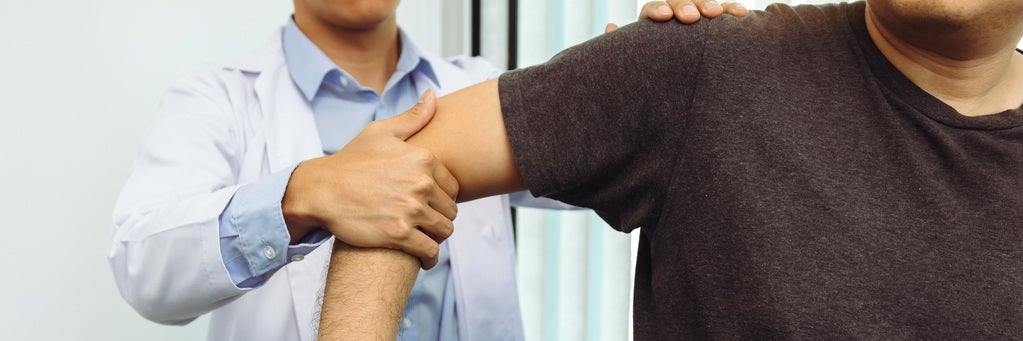 Chronic shoulder pain is a type of shoulder pain that typically develops over time and lasts for a period of longer than six months. The symptoms may be persistent or come in the form of flare-ups depending on the underlying cause of the chronic shoulder pain. This can be a result of tissue degeneration, inflammation, or injury.
Chronic shoulder pain is a type of shoulder pain that typically develops over time and lasts for a period of longer than six months. The symptoms may be persistent or come in the form of flare-ups depending on the underlying cause of the chronic shoulder pain. This can be a result of tissue degeneration, inflammation, or injury.Four Categories of Illness & Injury That Led to Shoulder Pain
Shoulder pain can be gradual or develop suddenly, leaving you with discomfort and limitations. The symptoms of shoulder pain depend on the specific cause and can vary greatly. The four main causes of shoulder pain include the following:
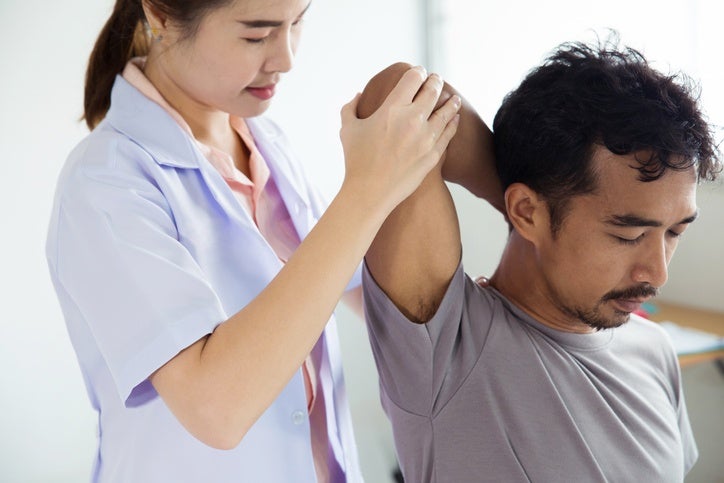
- Acute trauma
- Wear from repetitive use
- Sprains or strains
- Disease
Acute Trauma
Acute trauma refers to an event or accident that results in an impact on the shoulder. When the shoulder is hit from the front or back with force, it may be subject to internal bone damage, soft tissue damage, or a combination of both. This can occur in car accidents, falls, sports-related injuries, and other traumatic events.
Wear from Repetitive Use
For those who work in manual labor, such as carpenters or painters, or for those who play contact sports or sports that require overhead reaching, wear from repetitive use is a common reason for shoulder pain. Wear from repetitive use means engaging in the same motion consistently, resulting in a stress injury to the bones or tendons in the shoulder.
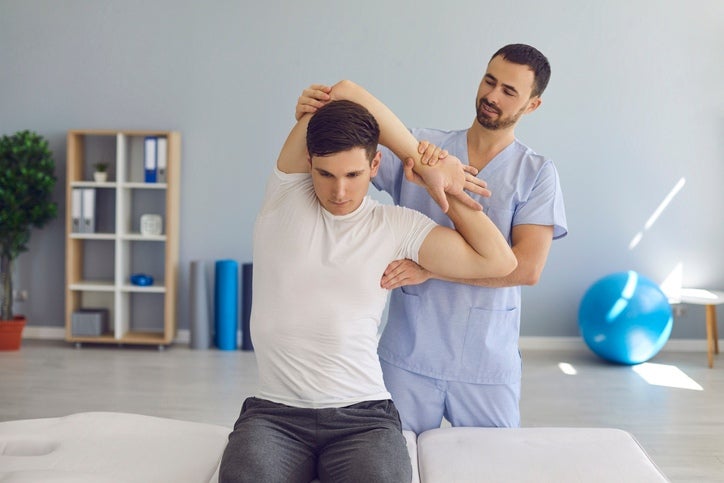
Sprains or Strains
Some movements or activities may strain the shoulder muscles or sprain the shoulder ligaments, even if they are not constantly repeated. For instance, when reaching for an item placed down low or up high, lifting a heavy item, or moving or twisting in an unusual position may cause a sprain or strain to the shoulder.
Disease
Certain diseases may result in shoulder pain. The most frequently seen disease that results in shoulder pain is osteoarthritis, which deteriorates the cartilage that protects the bones from rubbing. Rheumatoid arthritis is also common, as it targets the connective tissue and may result in shoulder pain.
Five Conditions That Lead to Shoulder Pain
Five conditions are commonly identified as the reason for shoulder pain. The five common conditions include:
- Arthritis
- Rotator cuff tears
- Tendinitis
- Bursitis
- Shoulder dislocation
Medical Treatments for Shoulder Pain
Before determining the most effective treatment, it’s important to detect what causes shoulder pain. Once the cause is established, your healthcare provider may recommend one of the following treatment methods to alleviate the pain:
- Physical therapy
- Chiropractic care
- Non-steroidal anti-inflammatory medication
- Lifestyle modifications
- Steroid injections
- Corticosteroids
- In severe cases or as a last resort, surgery
At-Home Management of Shoulder Pain
Acute shoulder pain and certain forms of chronic shoulder pain can be managed at home with the following treatments:
- Apply a cold compress to the affected shoulder to reduce swelling and ease the pain
- Rest and lifestyle modifications to ease the strain
- Anti-inflammatory medications and pain relievers
- Moist heat application
- Muscle relaxers
How to Prevent Shoulder Pain
It’s important to take the necessary precautions to avoid shoulder pain, including the following:
- Stretch before and after physical activity
- Use proper form when lifting heavy objects or reaching overhead
- Take breaks during repetitive movements that affect the shoulders
- Maintain good posture
- Eat a nutrient-rich diet to support your bone health
When to Consult a Doctor
If, after rest and limited movement to the affected shoulder, a person is still experiencing pain or the pain is severe, relentless, or derives from an injury, it’s important to seek medical intervention immediately. Furthermore, if the shoulder is dislocated or injured from trauma, it’s imperative to go directly to the emergency room.
Prevent Shoulder Pain with Fidel Integrated Medical Solutions
If you’re navigating the symptoms of shoulder pain or interested in learning how to prevent shoulder pain by engaging in a healthier, more balanced lifestyle, Fidel Integrated Medical Solutions is here to provide you with the guidance and expertise you need. Contact us today to schedule a consultation with our medical professionals.
-
What is Bursitis and how can it lead to shoulder pain?
What Is Bursitis of the Shoulder?
Shoulder bursitis occurs when the bursae become inflamed. Bursae are sacs filled with fluid that serve as padding between the connective tissue and bones, which facilitates the movement of tendons, bones, and muscles. Whether from injury or wear and tear, an accumulation of fluid in the bursae may result in shoulder bursitis.
Types of Shoulder Bursitis

There are three types of shoulder bursitis, including the following:- Chronic – A result of repeated injuries of acute bursitis. Symptoms of chronic bursitis may come in flare-ups, or they may be ongoing.
- Acute – Acute bursitis happens suddenly due to an injury and results in pain when the shoulder is moved or touched.
- Infectious or Septic – Infectious bursitis is rare and derives from bacterial infections.
What Causes Shoulder Bursitis?
Bursitis is not limited to the shoulder; however, shoulder bursitis is the most common form of bursitis. Shoulder bursitis derives from overuse, repeating the same shoulder movement, or impact or injury to the shoulder. Overhead movements enhance the friction between the tissues and bones, resulting in inflammation that leads to bursitis.
Risk Factors for Shoulder Bursitis

While anyone can get shoulder bursitis, there are certain people with heightened risk, including the following:
- Athletes, including football, softball, and lacrosse players
- Painters, builders, and carpenters
- People with arthritis, rheumatoid arthritis, gout, diabetes, kidney disease, uremia, or thyroid disease
Shoulder Bursitis Symptoms
Shoulder bursitis symptoms can be gradual or sudden, and typically include a sharp pain, dull ache, or tenderness. Other symptoms of shoulder bursitis include:

- Stiff or swollen shoulders
- Limited range of motion due to pain
- Pain at night when laying on the hurt shoulder
- Sharp or pinch-like pain when engaging in overhead movements
What Other Conditions Lead to Shoulder Pain?
Many patients with shoulder bursitis also develop shoulder tendinitis, as both shoulder conditions result in stiff and inflamed shoulders. Other conditions that result in shoulder pain include the following:
- Shoulder dislocation
- Frozen shoulder
- Bone spurs
- Osteoarthritis
- Rotator cuff tears
- Shoulder impingement syndrome
How Is Shoulder Bursitis Diagnosed?
To diagnose bursitis, your healthcare provider will begin by reviewing your medical history and performing a physical examination to inspect your pain levels, stability, and range of motion. They may also perform an X-ray, an MRI, an ultrasound, or joint aspiration to drain the bursa and test the fluid to detect infection or gout.
How Can I Treat Bursitis at Home?
To manage the discomfort of shoulder bursitis at home, you may engage in the following:
- Limit stress to the affected shoulder by refraining from straining activities
- Cold compress to alleviate inflammation
- Over-the-counter pain relievers and nonsteroidal anti-inflammatory medications to reduce swelling and provide relief for the pain
What Are the Nonsurgical Treatments for Shoulder Bursitis?
Non-surgical shoulder bursitis treatments work to reduce inflammation and curb unpleasant symptoms that may accompany bursitis. The common forms of non-surgical treatment include:
- Steroid injections in the bursa to ease swelling and pain
- Corticosteroids are taken orally for pain and inflammation
- Physical therapy and exercises for shoulder bursitis to improve weak muscles and range of motion
- Antibiotics to eliminate bacterial infections
What Are the Surgical Treatments for Shoulder Bursitis?
When shoulder bursitis cannot be alleviated or improved with non-surgical measures, surgery may be the only option. Shoulder bursitis surgery is performed arthroscopically with small incisions and a small camera. During surgery, your surgeon may remove damaged tissue or inflamed bursae.
What Are the Complications of Shoulder Bursitis?
Persistent shoulder bursitis can result in deterioration of the bursae, which may affect the mobility of the shoulder. In cases of infectious or septic shoulder bursitis, the bacteria may spread to other areas of the body. In severe septic cases, the patient may face life-threatening complications.
How Can I Tell Which Type of Bursitis I Have?
To determine what type of shoulder bursitis you have, it’s important to consult with your healthcare provider. Upon completion of a review of your medical history and a physical examination, your healthcare provider will be able to offer you insight into what type of shoulder bursitis you have and curate an effective treatment plan.
Alleviate Your Shoulder Bursitis Today
If you’re experiencing the pain and discomfort of shoulder bursitis, Fidel Integrated Medical Solutions is here to help you achieve relief with a range of health and wellness solutions, including physical therapy designed to ease the strain of your bursitis. Contact our friendly team today to consult with a professional about addressing your shoulder bursitis.
-
What Causes Shoulder Pain?
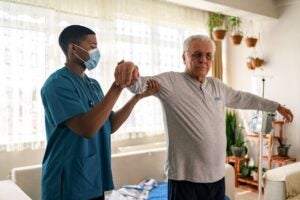
Shoulder pain can be debilitating, affecting your mobility and ability to carry out once simple tasks. While shoulder pain is a common occurrence, many don’t realize what causes shoulder pain and the many ways it can be alleviated. Fidel Integrated Medical Solutions is here to provide clarity and insight into what causes shoulder pain and how it can be remedied.
Types of Shoulder Pain
Shoulder problems can be categorized into two broad sections known as acute and chronic shoulder pain. Acute shoulder issues happen suddenly and are typically accompanied by intense discomfort. Chronic shoulder problems develop over time and may worsen without professional intervention. There are many types of acute and chronic shoulder problems.
- Frozen Shoulder – Frozen shoulder, also known as adhesive capsulitis, results in limited overhead mobility of the shoulder. This can be very painful and is typically the result of surgery or a shoulder, wrist, or hand injury.
- Shoulder Impingement Syndrome – Shoulder impingement syndrome is a condition brought on when the tendons of the rotator cuff located between the bones of the shoulder joint become pinched. This condition results in difficulty raising the arms overhead and is accompanied by sharp or shooting pains.
- Pinched Nerve – A common occurrence that may result in shoulder pain is a pinched nerve in the neck. Pinched nerves happen when a nerve root within the neck becomes compressed or irritated. This can be minor and heal on its own or it can be a part of a more complex issue such as a herniated disc or bone spur.
- Arthritis – Both rheumatoid arthritis and osteoarthritis, a degenerative joint disease, can cause pain and stiffness in the shoulder because of broken-down cartilage and friction between the bones.
- Torn Cartilage – Whether it derives from repetitive motions that affect the shoulder cartilage or an injury that inflicted an impact on the shoulder, torn cartilage may result in shoulder pain and weakness. Furthermore, torn shoulder cartilage may cause locking, grinding, or catching of the shoulder.
- Rotator Cuff Tear – Rotator cuff tears can occur due to overuse, normal wear and tear of the shoulder as you age, or from an accident or injury. Rotator cuff tears are accompanied by sharp pains when trying to lift or move things, and at night.
- Tendinitis/Tendinosis – Tendinitis is inflammation or irritation of the tendons within the shoulder joint. With consistent use, accident, or injury, the tendons may tear, leading to tendonitis. The symptoms of tendinitis may include pain, tenderness, limited range of motion, weakness, or stiffness of the shoulder.
- Shoulder Dislocation – Excessive force from an accident or injury may result in shoulder dislocation. When a shoulder becomes dislocated, a person may experience weakness, swelling, bruising, or numbness partnered with pain and discomfort.
- Bursitis – Overuse, heavy impact, or injury can result in bursitis in the shoulder. Bursitis is caused by the sac that serves as padding for shoulder movement becoming inflamed and irritated, which may result in discomfort and a burning sensation that predominantly occurs with movement.
- Bone Spurs – Bone spurs, also called osteophytes, are growths that can form on the edges of the bones located in the shoulder joint. Bone spurs are generally a result of consistent wear and tear to the joint, and they can develop into tendinitis or rotator cuff tears when not promptly addressed.
- Fracture – Whether a person is in an accident or experiences a fall, they may find themselves with a bone fracture. Bone fractures of the clavicle (collarbone) or the humerus (upper arm) may create shoulder pain as they heal.
- Referred Pain – In some cases, a patient’s shoulder pain may not have anything to do with the shoulder itself. Issues with other parts of the body, such as the gallbladder, stomach, liver, heart, or other organs may be damaged or ill, resulting in referred pain felt in the shoulder.
How to Diagnose What Causes Shoulder Pain
When you seek relief from a medical professional for your shoulder pain, they will begin your diagnosis by reviewing your medical history and performing a physical examination. Furthermore, they may conduct one of the following to detect the source of your pain:

- X-rays
- Magnetic resonance imaging (MRI)
- Computed tomography scan (CT scan)
- Electromyogram (EMG)
- Ultrasound
- Laboratory testing
Treating Shoulder Pain
Treatment for shoulder pain will vary depending on the source of the shoulder pain and the severity of the patient’s discomfort. Common shoulder pain treatment includes the following:
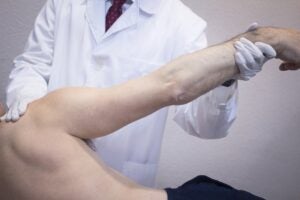
- Physical therapy
- Non-steroidal anti-inflammatory medication to alleviate inflammation and pain
- Surgery in severe cases
- Activity modification
- Rest
- Chiropractic care
Determining Treatment
Treating shoulder pain will be different for each patient, as treatment is based on several factors, including the following:
- The patient’s age
- The patient’s health and medical history
- The severity of the patient’s condition
- The patient’s tolerance to certain procedures, therapies, or medications
- The patient’s expectations
- The patient’s preferences
How to Manage Shoulder Pain
There are several methods to relieve and soothe shoulder pain, including the following:
- Rest
- Limit stress to the shoulder by modifying or refraining from certain activities
- Non-steroidal anti-inflammatory medications
- Cold compress to combat swelling
- Moist heat application
- Muscle relaxants
Get Shoulder Pain Relief Today
Don’t let shoulder pain hold you back. Rely on the medical professionals at Fidel Integrated Medical Solutions for prompt and effective shoulder pain treatment based on your specific needs and preferences. Contact us today to schedule a consultation and discover a life beyond the restraints of shoulder pain.
-
How Long Do Trigger Point Injections Last
Understanding the Results of Trigger Point Injections
At Fidel Integrated Medical Solutions, we are committed to helping patients discover the most effective and minimally invasive treatments for their pain. That’s why we provide trigger point injections. Suitable for patients struggling with chronic muscle or joint pain, trigger point injections can be used as a stand-alone or combination treatment to help alleviate and manage pain.
What Are Trigger Point Injections?

Trigger point injections are targeted injections used to alleviate pain in the muscles by inactivating the trigger points with numbing or a combination of medications, including:
- Numbing medication, such as lidocaine
- A combination of steroids and numbing medication
- Corticosteroids or regular saline
- Botox injections
- Dry needling
Do Trigger Point Injections Work Immediately?
A trigger point injection appointment takes 15-30 minutes, depending on the number of injections needed. While each patient will respond differently to trigger point injections, many patients notice relief immediately following their injections. However, the results of trigger point injections may take 2-3 days to settle in.
Do Trigger Point Injections Hurt?
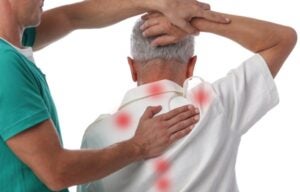
If you’re wondering what to expect after trigger point injections and during treatment, you will be glad to know that these injections are not known to be painful and are typically well tolerated. You may experience a slight soreness at the injection site following treatment, and the treatment itself is similar to the feeling of having your blood drawn.
Trigger Point Injection After-Care
Following your trigger point injections, you will be asked to remain under observation for 30 minutes. Once the 30 minutes are over, you may return to your usual daily activities while refraining from heavy physical activity until your muscles have relaxed entirely. Once you are no longer sore, stretching to strengthen the muscles to promote optimal healing is important.
How Long Do Trigger Point Injections Last?
The duration a patient will experience relief following a trigger point injection will depend on several factors, including the severity and specific pain condition the patient suffers from and the combination of medications used in their trigger point injection. Results may last anywhere from a couple of days to months.
Side Effects of Trigger Point Injections
Trigger point injections’ side effects are low risk, with little or no adverse reactions or complications for most patients. Depending on the combination of medication used in your trigger point injection, possible side effects could develop surrounding the injection site and may include:
- Soreness or tenderness
- Bleeding
- Pooling blood under the skin (hematoma)
- Infection
- Skin dimpling
What Are Trigger Point Injections Used for?
Patients navigating chronic pain conditions involving the muscles and joints may use painkillers that no longer provide adequate or long-lasting relief. In these cases, trigger point injections can be used as an alternative. Common conditions treated with trigger point injections include:
- Myofascial pain
- Fibromyalgia
- Tension headaches
- Neck or back pain
- Shoulder pain
- Groin pain
How Many Trigger Point Injections Can I Receive?
You may receive several trigger point injections per appointment. However, trigger point injections that contain steroid medication should only be used to alleviate pain as a part of a medical treatment plan, and no more than six injections should be given. Injections without steroids can be given more frequently with fewer limitations.
How Often Can You Get Trigger Point Injections?
The frequency in which a patient should pursue trigger point injections will vary depending on their unique pain symptoms, condition, and the medications used in their trigger point injections. Only one trigger point injection is needed in mild cases, whereas more severe cases will require weekly, ongoing treatment.
Learn More About Trigger Point Injections Today
If you’re interested in alleviating symptoms of pain that have been holding you back from living your life, Fidel Integrated Medical Solutions is here to help with our trusted trigger point injections. Contact us today to discuss your treatment and schedule your appointment with our medical professionals.
-
Trigger Point Injection Side Effects in Pikesville, MD
Exploring Trigger Point Injections
Chronic pain can be debilitating, affecting your physical health, mental well-being, and quality of life. That’s why at Fidel Integrated Medical Solutions, we are proud to offer a range of pain relief treatments, including our minimally invasive and highly effective trigger point injections.
What Are Trigger Point Injections?
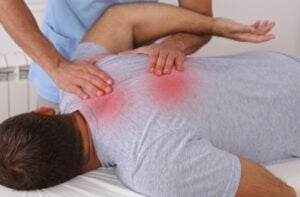 Trigger point injections are a non-surgical pain relief treatment administered by injection into the targeted trigger points in a patient’s muscles in various areas across the body, including the neck and back. Trigger point injections reduce tension and instantly relax the muscles to promote pain relief and comfort.
Trigger point injections are a non-surgical pain relief treatment administered by injection into the targeted trigger points in a patient’s muscles in various areas across the body, including the neck and back. Trigger point injections reduce tension and instantly relax the muscles to promote pain relief and comfort.Benefits of Trigger Point Injections
Trigger point injections are highly effective and offer a wealth of benefits, including:
- Instant pain relief
- Low-risk with minimal side effects
- Minimally invasive with virtually no recovery period
- A versatile pain solution that can be used for a variety of pain symptoms
What to Expect After Trigger Point Injections
 Trigger point injections offer prompt treatment time and no required downtime. Following the injection, patients are asked to remain under observation for up to 30 minutes to ensure no adverse reactions. Once discharged, patients may use ice packs to alleviate soreness around the injection site or inflammation, and stretching is encouraged.
Trigger point injections offer prompt treatment time and no required downtime. Following the injection, patients are asked to remain under observation for up to 30 minutes to ensure no adverse reactions. Once discharged, patients may use ice packs to alleviate soreness around the injection site or inflammation, and stretching is encouraged.Are Trigger Point Injections Painful?
If you’re considering trigger point injections, you may wonder if trigger point injections hurt. The injection may feel similar to the sensation of the needle used when having your blood drawn, but they are generally well tolerated by patients. After your treatment, you may feel mild soreness or inflammation.
What Is Used in Trigger Point Injections?
Trigger point injections are a combination of several medications used to relax and relieve muscle discomfort and pain. Based on the severity of the patient’s pain and symptoms, the following may be used:
- Numbing medication, such as lidocaine
- A combination of steroids and numbing medication
- Corticosteroids or regular saline
- Botox injections
- Dry needling
Do Trigger Point Injections Work?
A muscle impacted by trigger points loses its ability to relax, making movements or touch uncomfortable. Trigger point injections with numbing medications make the pain sensation dormant. When trigger point injections are combined with corticosteroids, they can soothe the muscles and alleviate spasms and inflammation, and when combined with Botox, they paralyze the muscle.
Conditions Treated With Trigger Point Injections
Several medical conditions can be treated with the use of trigger point injections, either on their own or in combination with other forms of therapy or treatment, including:
- Trigger point syndrome pain
- Myofascial pain
- Fibromyalgia
- Neck and lower back pain
- Tension headaches
How Is a Trigger Point Injection Administered?
Trigger point injections are administered to a patient while seated or in a reclining position. Our medical professionals will clean and numb the skin before injecting the numbing medication or combination of numbing, steroid, or Botox medication into the area of concern. A patient may receive more than one injection per appointment.
How Long Do Trigger Point Injections Last?
Trigger point injections provide instant relief. However, the final results may take 2-3 days. The pain relief provided by trigger point injections may last anywhere from several days to several months, depending on the patient’s trigger point injection medication combination and their current pain condition.
Quick and Convenient Treatment Time
Trigger point injections offer a prompt and convenient treatment time. A typical trigger point injection appointment takes 15-30 minutes, depending on the number of trigger point injections you pursue. The quick treatment time and the lack of downtime required to make trigger point injections a favorable solution for pain relief.
Safe and Effective Pain Relief
Trigger point injections are highly effective and safe, offering patients a low-risk alternative to conventional pain relief methods. The results of trigger point injections are instantaneous, and the treatment does not require downtime, allowing patients to feel great and get back to their usual routine without needing to carve out recovery time following their appointment.
Minimally Invasive
Trigger point injections are minimally invasive as simple injections require no surgical procedures. This allows patients to let go of their worries about scarring and anesthesia, alleviating anxiety and making them feel comfortable when arriving at Fidel Integrated Medical Solutions for their trigger point injection treatment.
Let’s Discuss Your Trigger Point Injections Treatment Today
If you’re looking for an effective, minimally invasive method to restore your muscle function and alleviate pain symptoms, don’t look up “trigger point injections near me,” as Fidel Integrated Medical Solutions is here to accommodate you. Contact us today to learn how trigger point injections can benefit you.
-
6 Steps To Better Health
 Steps to Better Health
Steps to Better Health1. GET PLENTY OF REST
The body heals when it rests. Sleep with one pillow , ask your chiropractor about a cervical pillow (it’s good for stiff necks and headaches.) Sleep preferably on your back or side. DO NOT SLEEP ON YOUR STOMACH.
2. EXERCISE
However, it must be the right type of exercise for you. Skydiving may be exercise, but not necessarily the ideal exercise for you. There are specific abdominal, neck and low back exercises that everyone can do to strengthen their spine. Cardiovascular (CV) exercise, the type of exercise that increases your heart rate is a MUST . Examples of CV exercises are brisk walking, swimming bicycle riding, stair stepper, stationary bike, treadmill etc. 20-40 minutes 3-4 x’s per week will improve your overall health and burn off excess fat. Studies show those in better cardiovascular condition heal faster!
3. POSITIVE MENTAL ATTITUDE
Your attitude and outlook affect how you feel and how you heal.
Laugh, smile. Set goals for yourself. Figure out what it is that you want in life, write it down and visualize it. With a positive attitude, goal setting and some action steps ANYTHING IS POSSIBLE!
4. EAT RIGHT
What does that mean? Here are some quick tips. Read labels. If the first ingredient is one of the “three whites” STAY AWAY. They are 1-sugar (also known as glucose, fructose. Sucrose, etc.) 2- salt (also known as sodium, sodium chloride) and 3-enriched flour.
Drink 6-8 glasses of water a day. Remember not tea, not lemonade, not juice, WATER!
Eat plenty of veggies and fruit. Remember fresh is best, then comes frozen. Canned veggies lose most of their nutritional value- you’re probably better off eating the can!
Decrease your fat intake and make smart choices . MODERATION IS THE KEY!
5. GOOD POSTURE
- Proper lifting. Always bend at your knees.
- Avoid poor telephone habits such as holding the phone between your ear and shoulder, without your hands
- Men: Don’t sit on your wallet while driving.
- MOMS: Avoid holding your baby on your hip while cooking and talking on the phone.Better Posture leads to a healthier spine and nervous system.
6. MAINTAIN INTEGRITY OF YOUR SPINE & NERVOUS SYSTEM
What? You probably never heard this before. All functions of your body are controlled by you brain and nervous system. That’s how you feel things, how your organs and immune system function and how your muscles operate, through your nervous system. The nerves come out from your spinal cord to the rest of the body in order to do their job. The vertebrae or spine surrounds the spinal cord. Anytime there is a subluxation (misalignment) of the vertebrae, it causes interference in the nervous system and function of the body. Back pain and neck pain are a signal that there is nerve interference occurring. However, misalignments or subluxations, occur often, interfering with the way your body functions and killing off cells, without pain occurring.
It is important to get your spine checked by a chiropractor to make sure that you don’t have spinal misalignments (subluxations) especially if you are not having any pain. This can prevent future pain, and KEEP YOU HEALTHY . Chiropractic is about being healthy, and about having a proper functioning nervous system and spine.
If you follow all six steps, you’ll be on your way to a happy healthy lifestyle. Remember lots of small steps and small changes add up. Make positive changes in your life and tell others!
FIDEL CHIROPRACTIC CENTER
-
Prolonged Sitting Is The “new Smoking” It’s Not Good For You!!
You’ve probably been told as a child, to sit up straight and stop slouching. But it was not until the start of my professional career that I truly began to understand the importance of proper posture and the difficulty of fixing it once it’s become problematic. Specifically, the problem with prolonged sitting is that it often leads to muscle imbalances in the neck, shoulders, lower back and hips. With prolonged sitting muscles are not only placed in shortened positions, but are also neurologically facilitated and programmed to become increasingly short and tight. Over time these muscle imbalances can cause tension headaches, low back pains, disc herniations and even an increased chance for arthritis.

With all of these muscle imbalances the body loses the ability to keep it’s joint’s centered as it moves through a given motion. Depending on the region, this can cause arthritic changes to the neck and back, it can wear through soft tissue structures like spinal discs, rotator cuff muscles, or lead to an increased incidence of tension headaches originating
The simplest recommendation is that you stand up at least once an hour and move around. Not only will this get your blood flowing but it will help to combat against creep– the gradual onset of muscle contracture with prolonged sitting. Following good ergonomics can be another important step as well as taking micro-breaks. One of the best known micro-breaks was widely popularized by Dr. Stuart McGill at Waterloo University. The brief exercise involves standing up, stretching the arms up over the head and briefly reaching one arm, and then the other arm, toward the ceiling.
Prolonged sitting and lack of movement reeks havoc with your posture and nervous system thus lowering your state of health.
FIDEL CHIROPRACTIC CENTER
410-484-5642
1866F Reisterstown Rd
Pikesville, MD 21208““
-
Poor Posture Neck Pain and Answers!
Poor posture is the leading cause of neck pain!
When individuals consider neck pain, they generally associate it with careers in the hard labor industry such as construction or farm work. Although, those who sit in front of a computer often suffer from neck pain that is just as painful and, in some cases, debilitating. Individuals who perform office work on a daily basis often suffer from excruciating neck pain. Poor posture at the computer can cause neck pain! There are several steps these victims can take to combat this discomfort and work toward a healthier state.
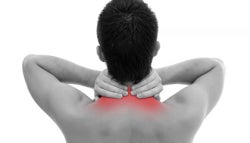 The US National Library of Medicine National Institutes of Health has reported that about 46% of individuals suffer from neck pain associated with sitting at a desk, and nearly 20% of these complained of chronic pain issues. This takes its toll, not only on physical and mental conditions, but on the wallet as well. In some cases, it means missing days from work and therefore a decrease in pay each week. In other cases, individuals not only miss work, but also must seek medical attention effectively increasing their monthly of medications, prescriptions or over-the-counter, and/or herbal remedies.
The US National Library of Medicine National Institutes of Health has reported that about 46% of individuals suffer from neck pain associated with sitting at a desk, and nearly 20% of these complained of chronic pain issues. This takes its toll, not only on physical and mental conditions, but on the wallet as well. In some cases, it means missing days from work and therefore a decrease in pay each week. In other cases, individuals not only miss work, but also must seek medical attention effectively increasing their monthly of medications, prescriptions or over-the-counter, and/or herbal remedies.Another measure they suggest is the traditional heat and ice therapy that is commonly used for children who participate in school sports. Ice should be applied to the area for the first 48 to 72 hours, followed by heat thereafter. Rest and relaxation is also strongly recommended. A day or two of simple rest can prevent a week or two of missing work. After some adequate rest, these professionals recommend slow range motion exercises. It is important to be cautious while performing these, or any type of exercises. Slow and methodical motions are best so as not to over use the afflicted muscles and prevent further damage with poor posture neck pain.
Chiropractic care is the most cost effective, holistic way to relieve neck pain. Gentle techniques can be used to work out the kinks and restore function. You will learn some basic posture correction to cure poor posture! Combining chiropractic care and physical therapy can be the fastest way to feel relief from poor posture and neck pain.
FIDEL CHIROPRACTIC CENTER
410-484-5642
1866F Reisterstown Rd
Pikesville, MD 21208““
-
5 Helpful Remedies For Rheumatoid Arthritis
5 HELPFUL REMEDIES FOR Rheumatoid Arthritis
(Aside from getting adjusted and physical therapy)
ICE MASSAGE. Simply rubbing an ice cube or a paper cup of frozen water in small circles over a painful area reduces swelling, slows pain signals and inhibits the production of inflammatory chemicals. The American College of Rheumatology recommends doing it 5 to 10 minutes several times a day.
FISH. The omega-3 fatty acids in some fish reduce inflammation by halting the production of pro-inflammatory enzymes – and they can ease pain, too. The best sources include salmon, sardines, herring and tuna. Eat several servings per week.
WALKING. Few therapies can match walking for reducing pain and stiffness, building muscles around the joints and improving flexibility. Start as slowly as you need to, and work up to 30 minutes a day.
GREEN TEA. Studies show a potent antioxidant in green tea called epigallocatechin-3-gallate (EGCG) blocks the production of molecules that cause joint damage in people with rheumatoid arthritis (RA). To reap the health benefits, drink two or three cups of green tea a day, researchers suggest.
PROBIOTICS. In studies, certain strains of probiotic bacteria – “good” bacteria found in some foods, such as yogurt – significantly reduced pain and disability in people with RA. Though research is still preliminary, try eating yogurt every day for two or three months to see if it’s effective for you.
Call, if you have any questions:
410-484-5642
410-358-0060
Dr. Ilene Fidel
““
